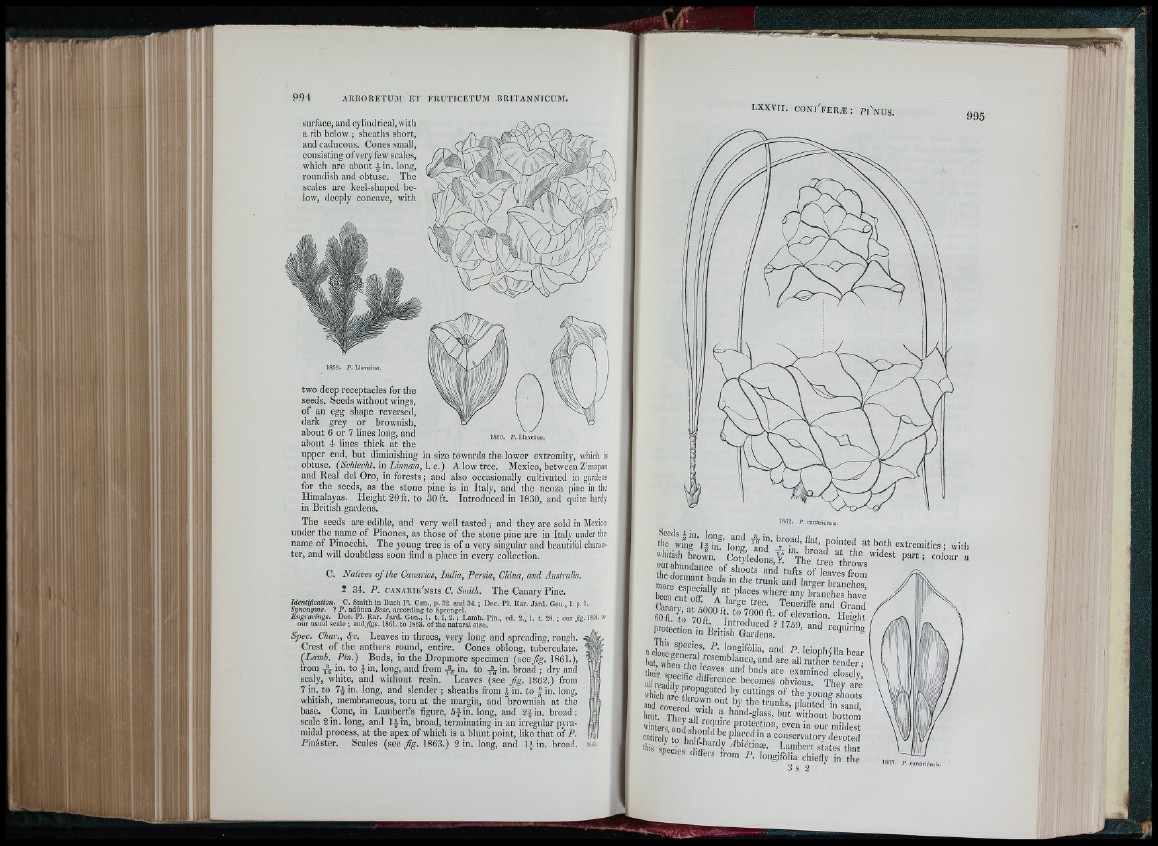
M
surface, and cylindrical, with
a rib below ; sheaths short,
and caducous. Cones small,
consisting ofveryfew scales,
which are about ^in. long,
roundish and obtuse. The
scales are keel-shaped below,
deeply concave, with
185y. p. Llaveàna.
two deep receptacles for the
seeds. Seeds without wings,
of an egg shape reversed,
dark grey or brownish,
about 6 or 7 lines long, and
about 4 lines thick at the
upper end, but diminishing in size towards the lower extremity, which is
obtuse. (Schlecht, in Linnæa, 1. c.) A low tree. Mexico, between Z'mapan
and Real del Oro, in forests; and also occasionally cultivated in gardens
for the seeds, as the stone pine is in Italy, and the neoza pine in the
Himalayas. Height 20 ft. to 30 ft. Introducedin 1830, and quite hai-dy
in British gardens.
The seeds are edible, and very well tasted ; and they are sold in Mexico
under the name of Pinones, as those of the stone pine are in Italy under the
name of Pinocchi. The young tree is of a very singular and beautiful chai-ac*
ter, and will doubtless soon find a place in every collection.
C. Natives ofthe Canaries, India, Persia, China, and Anstralia.
Î 34. P, c a n a r i e ' n s i s C. Smith. The Canary Pine.
Ideniijication. C. Smith in Buch Fl. Can., p. 32. and 34. ; Dec. P l, Ea r. Jard . Gen., 1. p. I-
Synonyme. ? P . adúnca Bosc, according to Sprengel.
Engravings. Dec. PI. Rar. Jard . Gen., 1. t. I, 2. ; Lamb. Pin., ed. 2., 1. t. 28. : our Jig. 18G4, to
our usual scale ; a n d j^ « . 1861. to 1863. o fth e natural size.
Spec. Char., Leaves in threes, very long and spreading, rough.
Crest of the anthers round, entire. Cones oblong, tuberculate.
(Lamh. Pin.) Buds, in the Dropmore specimen (se e /g . 1S61.),
from T^in, to ¿in. long, and from .5^ in. to ^ i n . broad ; dry and
scaly, white, and without resin. Leaves (see fig . 1862.) from
7 in. to 7¿ in. long, and slender ; sheaths from | in. to | in. long,
whitish, membraneous, torn at the margin, and "brownish at the
base. Cone, in Lambert’s figure, in. long, and 2¿in. broad;
scale 2 in. long, and l-¿in. broad, terminating in an irregular pyramidal
process, at the apex of whicli is a blunt point, like that of P.
Pinaster. Scales ( s e e /g . 1863.) 2 in. long, and l|-in. broad.
LX X V II. C O N I F E R Æ : P i ' n u s .
JS62. / ’.canariénsis-
been culteff A*'} 'fr’'®"® branches hav? s i- r
‘I'ei-- specifi allroa.m ®d iiffff eiencet eb efcoofom®e s obvexioaums.i nedT hcelovs ealiyv,.
» J covered IT h i r i he trunks, planted in sand,
heat. They all r e ^ hand-glass, but without bottom
'™ters,teLLteyte® even in our mildest
entirely to half h ir Ì ? Ì® ‘ “ ® e^revvatory devoted
'bi® sPpeecciieess ddiitfffteor s t efr om P. longifòlia chie®fl'ya teisn tthhaet
3 s 2